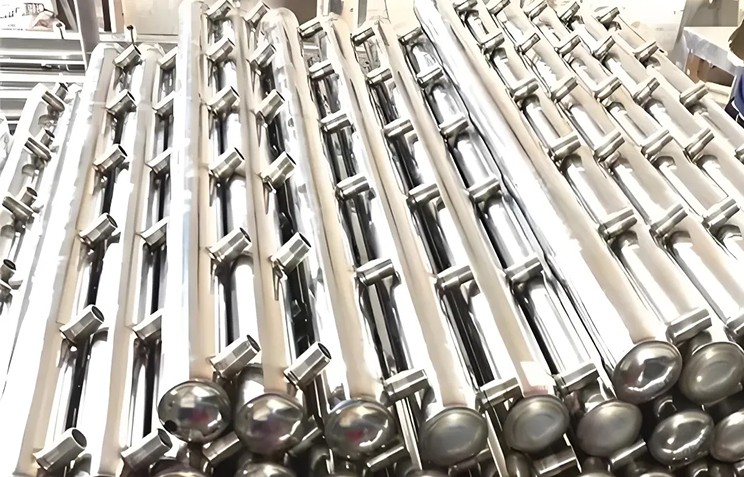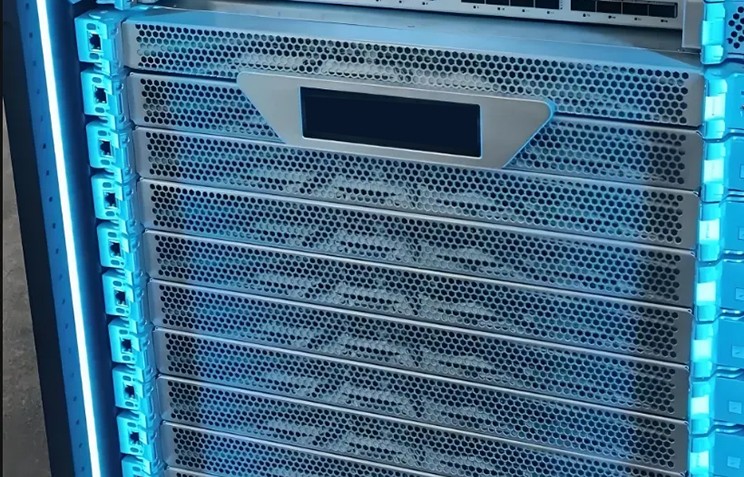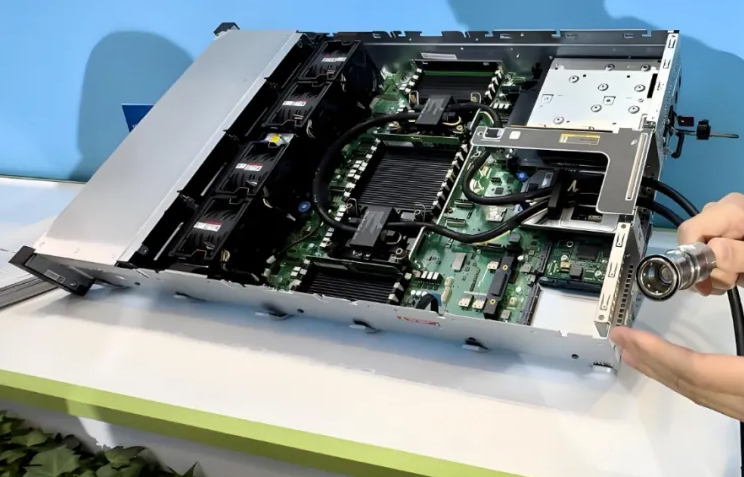As data center power densities continue to increase, liquid cooling technology is increasingly being used in high performance computing (HPC) and artificial intelligence (AI), where manifold plays a key role. NVIDIA's recent launch of multi-node liquid cooling rack scale-out systems based on the GH200 and GB200 (e.g., GB200 NVL72) further highlights the importance of manifold in supporting high-density computing and efficient heat dissipation. Studies have shown that its manufacturing accuracy (e.g., ±0.1mm) is critical to thermal efficiency and system stability.
The manifold is an integral component of a liquid cooling system. Its primary function is to evenly distribute coolant from the cooling source or Coolant Distribution Unit (CDU) to the components that require heat dissipation (e.g., server cooling plates), and to recycle the warm coolant back to the source for re-cooling. Through precise design, manifold ensures uniform distribution, stable pressure and optimized flow rate of coolant to avoid localized overheating or undercooling and ensure efficient system operation.

Vacuum Brazing Liquid Cooling Manifold Role
1. Even distribution of coolant
The liquid cooling manifold distributes the coolant evenly to each cold plate or device through the internal precision runner design, ensuring that the heat is taken away efficiently. In high-density computing scenarios, uniform coolant distribution significantly improves cooling efficiency and prevents hardware failures caused by localized overheating.The Lori manifold ensures consistent coolant distribution through optimized runner design. In the NVIDIA GB200 NVL72 system, the manifold is required to support the efficient heat dissipation of 72 Blackwell GPUs and 36 Grace CPUs, reflecting its key role in multi-node liquid-cooling architecture.
2. Recycling return coolant
Manifold is not only responsible for coolant distribution, but also takes on the task of recovering warm coolant and sending it back to the cold source or CDU for recirculation cooling. This closed-loop design improves system energy efficiency and reduces coolant waste. NVIDIA's multi-node liquid cooling rack expansion systems for GH200 and GB200 achieve closed-loop cooling of large-scale GPU clusters through manifold, ensuring long-term stable operation.
3. Pressure management and flow rate optimization
Manifold is designed to ensure a uniform flow rate of coolant to avoid excessive pressure drop or uneven flow rate affecting the cooling effect. Studies have shown that improperly designed quick couplings or elbows may lead to unbalanced flow rates and reduced cooling efficiency. Therefore, optimizing the flow path design with the help of Computational Fluid Dynamics (CFD) simulation has become an important means to improve system performance. In the NVIDIA GB200 NVL72, manifold works with the NVLink switching system to support 130TB/s low-latency GPU communication, further optimizing flow rate and pressure management.
4. Ease of maintenance
Lliquid cooling manifolds are usually equipped with drip-free quick couplings that support online plug-and-play maintenance. Users can replace or repair cold plates without interrupting system operation, dramatically increasing system availability. This feature is especially important in high-reliability scenarios such as data centers. NVIDIA's liquid cooling rack systems (such as the GH200 and GB200 NVL72) adopt a similar design, with drip-free connectors that reduce maintenance risks and ensure long-term stable operation under high loads.
5. Enhanced system reliability
Manifolds are made of high-strength, corrosion-resistant materials such as 6061 aluminum alloy, which can withstand the harsh environment of high-pressure and high-traffic in data centers to ensure long-term reliability, and Lori manifolds are designed to be rugged and durable for high-density computing needs. In the NVIDIA GB200 NVL72 rack system, manifold supports power consumption of up to 120kW, demonstrating its reliability under extreme conditions.
6. Precision manufacturing and design features
Manifold's manufacturing precision directly affects its performance. By precisely controlling the position of the piping (e.g. ±0.1mm), it ensures that the coolant is evenly distributed to each branch and improves heat dissipation efficiency. Depending on the application scenario, users can choose between a single-row pipe (for limited space or low-power requirements) or double-row pipe (for high-power devices such as AI servers) design. NVIDIA's liquid cooling rack scale-out systems based on the GH200 and GB200 further advance this technology, with the GB200 NVL72 supporting higher power densities through a dual-node design and liquid cooling manifold.
Other Key Components of a Liquid Cooling System
The liquid cooling system is a complex closed-loop system that includes several key components in addition to the manifold and cold plate that work together to achieve efficient heat dissipation. Below are the key components and their roles:
Cold Source (Chiller)
The cold source is the starting point of a liquid cooling system and typically employs refrigeration equipment (e.g., a water cooler or evaporative cooler) to reduce the temperature of the coolant to a set value (typically 15-25°C). The cold source removes heat from the system by exchanging heat with an external environment, such as a cooling tower. A highly efficient cold source significantly improves the ability of the coolant downstream of the manifold to dissipate heat.
Coolant Distribution Unit (CDU)
The CDU is the bridge between the cold source and the manifold and is responsible for the primary distribution and management of the coolant. It has a built-in pump, filter and temperature control system to ensure that the coolant is delivered to the manifold at a constant pressure and flow rate. the CDU also monitors the status of the coolant, preventing impurities or air bubbles from entering the system and guaranteeing the stable operation of the manifold.
Cold Plate
Cold plate is in direct contact with heat generating components (e.g. CPU, GPU), absorbing heat through internal micro-fluidic channels and transferring it to the coolant. Vacuum brazed aluminum cold plates are preferred for high performance computing due to their high thermal conductivity and precision manufacturing (e.g. flatness <0.03mm). The cold plate works in tandem with the manifold to ensure efficient heat transfer from the device to the coolant.
Pumps
Pumps provide circulating power for the coolant and are usually integrated into the CDU or set up independently. Their flow rate and head need to be matched to manifold's flow path design to maintain pressure balance and flow uniformity within the system. High-performance pumps, such as centrifugal or magnetic pumps, reduce fluid resistance and improve overall cooling efficiency.
Heat Exchanger
A heat exchanger is responsible for the exchange of heat between the coolant and an external medium such as air or water, and is usually located at the end of the cooling source or system. Plate heat exchangers are widely used for their compactness and efficiency, and are used in conjunction with manifolds to optimize the heat recovery and recooling process.
Tubing/Piping
Tubing connects the various components of the system and transports the coolant to the manifold and the cold plate. They are made of corrosion-resistant metals (e.g., 6061 aluminum alloy) or polymers (e.g., PTFE) and require low leakage and high pressure resistance. The layout of the piping and the design of the fittings have a direct impact on the pressure management and fluid distribution efficiency of the manifold.
These components form an efficient and synergistic system with the manifold to ensure stable circulation of coolant in a closed loop, realizing precise thermal management from heat source to cold source.
Vacuum brazed liquid cooling manifolds, as the core components of liquid cooling systems, play an irreplaceable role in modern data centers by evenly distributing coolant, managing pressure and flow rate, and enhancing reliability and easy maintenance. NVIDIA's multi-node liquid cooling rack expansion systems based on GH200 and GB200 (e.g., GB200 NVL72), combined with vacuum brazed aluminum cooling panels and other components for efficient heat dissipation, fully demonstrate manifold's key position in supporting high-density computing. With the rapid development of AI and HPC, its application prospect will be even broader. Based on the latest technologies and processes, manifold and related components are continuing to evolve towards higher precision, higher efficiency and greater reliability, becoming an important pillar in supporting thermal management in high-performance computing environments.








